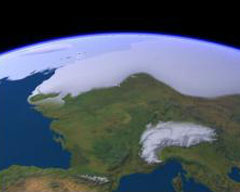| The Last Ice Age | Animation ID : AEA_5630 |
| PAL 4:3 | |
| PAL 16:9 | |
| HD 720 | |
| HD 1080 | |
Approaching North America in the grip of the last ice age, sea levels are 80m lower than today. We descend as we cross the Atlantic to view Western Europe in more detail: the Scandanavian and Alpine icecaps advance as sea levels drop to 120m lower than today.
The polar icecaps grow and shrink with a cycle of some 100,000 years, largely due to periodic variations of the Earth's distance from the Sun and the wobbling of the Earth's axis of rotation. Minor ice ages occur at more frequent intervals as the Earth's climate system adjusts to the changes brought on by the major cycle.
We are currently in a warm period between ice ages, but 20,000 years ago ice sheets covered Northern Europe and much of North America. Sea levels were 120 metres lower due to the amount of water locked up as ice on the land, creating land bridges between Alaska and Siberia and between Britain and mainland Europe. In Europe, primitive peoples had a taste of the Arctic as the Scandinavian icecap advanced from the north and the Alpine and Pyrennean icecaps from the south. The glaciated valleys of the Alps, Scandanavia and Britain testify to the scale of the changes brought about in the landscape.
Credit : Planetary Visions Ltd.









